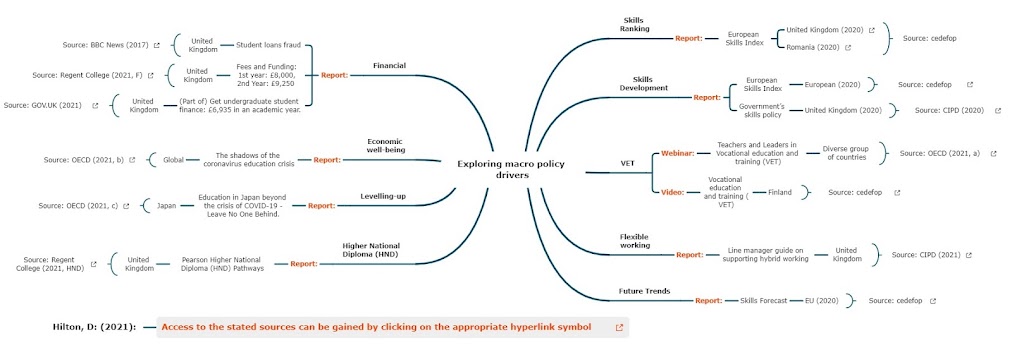Summary of the information on different international reports/reviews of skills development in different countries, which might impact the HRD strategy - of Regent College London - known to author.
An interactive version of the outlined macro policy drivers can be accessed by clicking on the Mind-map below:
Hilton, D. (2021): Mind-map. URL: http://www.xmind.net/m/BLYrVy
Primarily, the most prized sources are associated with the delineated Financial Drivers; this it because the organisation - I have been working for - is a private college who KPIs (Key Performance Indicators) are linked to: Profitability, Liquidity, Financial Efficiency and Share-holder value.
Secondly, the most valued sources are associated with the outlined Skills Drivers; e.g., Skills ranking, Skills development and Vocational educational & training (VET); this is because this comparative reference material effectively benchmarks, Return on Human-capital Employed (ROCE) and general performance levels.
Lastly, the most advantageous sources are associated with the outlined Economic Drivers; e.g., Future-trends, HND Pathways, Economic well-being, Levelling-up and Flexible working; this is because these sources help triangulate the other drivers and inform broader stakeholders interests.
The challenges facing HRD professionals - in making sense of and keeping up to date on these broader issues of policy - as principally connected with identifying what are the most important macro policy drivers - influencing their environment's. Moreover, the corollary being how these issues will effect them.
For example - Hayes (2020). "A micro driver is anything that could materially affect either a company's earnings or the price of its stock. Every company will have its own unique drivers, although some of the most common drivers include the release of new products or services, new financing, commodity or resource prices, activities of competitors, legislation, regulation, and product diversification versus competitors. Micro drivers are most often employed in bottom-up analysis."
"Stock-specific drivers often have no pure quantitative units of measurement, but are more qualitative in nature such as investor sentiment. Qualitative drivers are often intangible and inexact, making it more difficult to collect and measure. Still, understanding people and company cultures are central to any holistic analysis. Looking at a company through the eyes of a customer and understanding its competitive advantage assists with understanding drivers of company success."
"Macro drivers are a big area of interest for fund companies running top-down strategies, as they're often concerned with what the global investment themes will be over their time horizon. Fundamental investors may be more concerned with micro drivers that affect the earnings and stock prices of the companies they are analysing. The best fundamental investors will identify the three or four key drivers for the stocks they own and follow the status of those drivers religiously, knowing that they hold the key to the overall performance of the stock."
Bibliography / References
- BBC (2017): Student loans fraud exposed by Panorama. [Online] Available at URL: https://www.bbc.co.uk/news/uk-41966571 [Last access: June 2021]
- CIPD (2020): Skills development in the UK workplace. Understand what we mean by skills in the workplace, UK skill levels and the government’s skills policy. [Online] Available at URL: https://www.cipd.co.uk/knowledge/work/skills/skills-factsheet#gref [Last access: June 2021]
- CIPD (2021): Flexible working, Line manager guide on supporting hybrid working. [Online] Available at URL: Line manager guide on supporting hybrid working | CIPD [Last access: June 2021]
- European (2020): Skills Development, European Skills Index, European Centre for the Development of Vocational Training (Cedefop). [Online] Available at URL: https://www.cedefop.europa.eu/en/publications-and-resources/data-visualisations/european-skills-index/skills-development [Last access: June 2021]
- EU (2020): Skills Forecast, Future Trends, (Cedefop). [Online] Available at URL: https://www.cedefop.europa.eu/en/publications-and-resources/data-visualisations/skills-forecast [Last access: June 2021]
- Finland (2021): Video: Vocational education and training (VET) in Finland, (Cedefop). [Online] Available at URL: https://youtu.be/VuOKaNmHzO0 [Last access: June 2021]
- Hilton, D. (2021): Mind-map. Exploring macro policy drivers. [Online] Available at URL: http://www.xmind.net/m/BLYrVy [Last access: June 2021]
- HAYES, A. (2020): Driver, Investopedia. [Online] Available at URL: https://www.investopedia.com/terms/d/driver.asp [Last access: June 2021]
- OECD (2021, a): Webinar: Teachers and Leaders in Vocational Education and Training (VET). [Online] Available at URL: https://youtu.be/CImIxnFm0ik [Last access: June 2021]
- OECD (2021, b): The shadows of the coronavirus education crisis. OECD Education and Skills Today. [Online] Available at URL: https://oecdedutoday.com/shadows-coronavirus-education-crisis/ [Last access: June 2021]
- OECD (2021, c): Levelling-up, Education in Japan beyond the crisis of COVID-19 - Leave No One Behind. [Online] Available at URL: https://www.mext.go.jp/en/content/20200904_mxt_kouhou01-000008961_1.pdf [Last access: June 2021]
- Regent College (2021, F): Fees and Funding. [Online] Available at URL: Fees and funding - Regent College London (rcl.ac.uk) [Last access: June 2021]
- Regent College (2021, HND): Higher National Diplomas. [Online] Available at URL: https://www.rcl.ac.uk/courses/higher-national-diplomas/ [Last access: June 2021]
